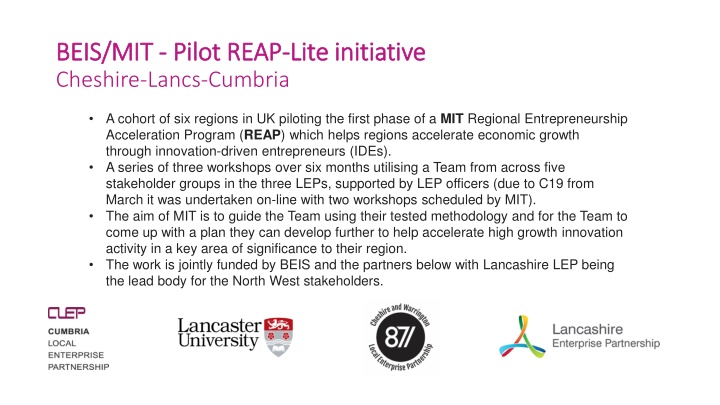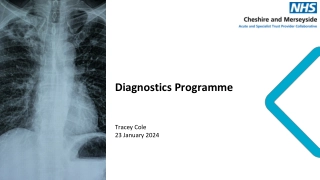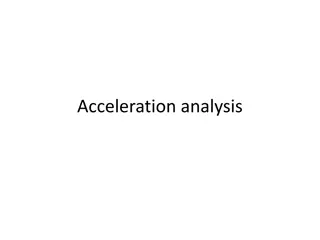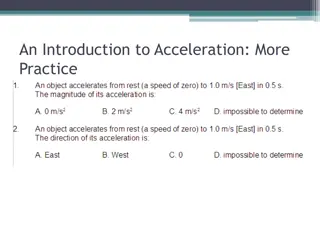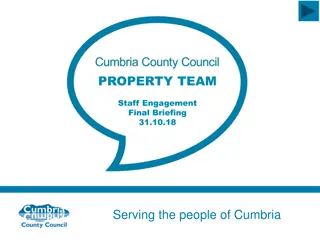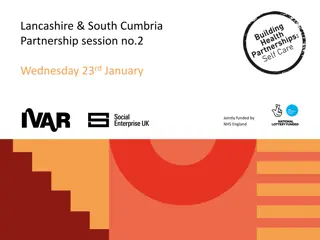MIT Regional Entrepreneurship Acceleration Program (REAP) - Cheshire-Lancs-Cumbria Initiative
A cohort of six UK regions piloting the first phase of the MIT REAP, aimed at accelerating economic growth through innovation-driven entrepreneurs. Stakeholders from various sectors collaborate to identify synergies, address risk capital issues, and focus on Clean Growth support and financing. The program targets key regional areas for high-growth innovation activity, guided by MIT's methodology for strategic planning.
Download Presentation

Please find below an Image/Link to download the presentation.
The content on the website is provided AS IS for your information and personal use only. It may not be sold, licensed, or shared on other websites without obtaining consent from the author.If you encounter any issues during the download, it is possible that the publisher has removed the file from their server.
You are allowed to download the files provided on this website for personal or commercial use, subject to the condition that they are used lawfully. All files are the property of their respective owners.
The content on the website is provided AS IS for your information and personal use only. It may not be sold, licensed, or shared on other websites without obtaining consent from the author.
E N D
Presentation Transcript
BEIS/MIT BEIS/MIT - - Pilot REAP Cheshire-Lancs-Cumbria Pilot REAP- -Lite initiative Lite initiative A cohort of six regions in UK piloting the first phase of a MIT Regional Entrepreneurship Acceleration Program (REAP) which helps regions accelerate economic growth through innovation-driven entrepreneurs (IDEs). A series of three workshops over six months utilising a Team from across five stakeholder groups in the three LEPs, supported by LEP officers (due to C19 from March it was undertaken on-line with two workshops scheduled by MIT). The aim of MIT is to guide the Team using their tested methodology and for the Team to come up with a plan they can develop further to help accelerate high growth innovation activity in a key area of significance to their region. The work is jointly funded by BEIS and the partners below with Lancashire LEP being the lead body for the North West stakeholders.
NW Team and our REAP Objectives NW Team and our REAP Objectives A Team from the 3 LEPs, Astra Zeneca(BioHub), Sellafield, FW Capital, Innovate UK, Lancaster University and two SMEs, Portswigger Ltd and Cows & Co Ltd represent a variety of sectors and stakeholder groups. Identifying synergies across the three LEPs and examining data to build on capabilities/opportunities from strategic work to date (LIS /SEPs) Addressing issues around risk capital and support for high growth companies of the future to define the Must Win Battle At the first MIT run workshop the Team considered the sub-regions specialisations and comparative advantage and identified two related areas for further work as follows: To focus on support for Clean Growth as uniting our capabilities with opportunities enhanced by more in depth analysis of business needs and specific areas of focus within Clean Growth and how it might be delivered at scale across the LEPs. To consider the financing of entrepreneurs engaged in realising Clean Growth - the team conceptualised an idea for a novel investment vehicle/partnership model. 2
Regional Specialisation / Comparative Regional Specialisation / Comparative Advantage Cheshire-Lancs-Cumbria Advantage Trends and Drivers - Cross-Sectoral Missions Accelerated Global Trends post C-19 Resource Efficiency & Resilience Digitilisation Decarbonisation Re-shoring Accelerated Innovation Manufacturing Aerospace, Automotive & Maritime Petroleum, Chemicals & Materials Energy Nuclear, Wind, Hydrogen Problem Definitions Relative weakness in R&D spend Insufficient high growth businesses of the future Disparate response to key opportunities Clean Growth urgency for change across all sectors Education, Science & Professional Services Health, Medicines Discovery & Manufacture Agri-Tech, Food, Natural Assets & Tourism 3
Initial Initial S Stakeholder Feedback takeholder Feedback Research and initial stakeholder engagement involved the Centre for Global Eco-Innovation (CGEI), Lancaster University Management School (LUMS) and FW Capital Ltd (who manage investments within the Northern Powerhouse Fund) to scope the issues around the Investment Vehicle and Clean Growth model. The findings were as follows: The LEPs aims for the broader support model for clean growth businesses needs to be defined on the basis of the Science & Innovation Audit (SIA) and partners operating at impactful regional and local scale We need to know more about the numbers and characteristics of, potential Investee Companies and their problems with existing finance, the delivery models and what sort of projects we would wish to support. Investors/Fund Managers like a broad geographical scale and remit so they can seek out the best investment opportunities/returns and an anchor investor fund size & sector experience with cost effective legal structures. Debt Funds rarely produce sufficient returns for private investors and equity investment would entail an exit route selling the shares back to management involving lower returns than trade sales. Therefore a scheme needs to have a Govt partner and the emphasis would be an Accelerator or deployment programme supporting existing Fund/s
Stakeholder Mapping Stakeholder Mapping CGEI Centre for Global Eco-Innovation http://www.globalecoinnovation.org/ LEC & CEH - https://www.lancaster.ac.uk/lec/ CNPPA Centre for National Parks & Protected Areas - https://www.cumbria.ac.uk/ Lancashire Enterprise Partnership - https://lancashirelep.co.uk/ Lancaster University Management School - https://www.lancaster.ac.uk/lums/ UCLan Centre for Waste Management https://www.uclan.ac.uk/ Edge Hill University - https://www.edgehill.ac.uk/ Energy Lancaster - https://www.lancaster.ac.uk/energy-lancaster/ Boost - https://www.boostbusinesslancashire.co.uk/ Myerscough College - https://www.myerscough.ac.uk/ Environment Agency https://www.gov.uk/government/organisations/environment-agency Cumbria LEP https://www.thecumbrialep.co.uk/ Cheshire & Warrington LEP http://www.871candwep.co.uk/ University of Chester https://www1.chester.ac.uk/ UK Geoenergy Observatory InfoLab21 - https://en.wikipedia.org/wiki/InfoLab21 Fraser House - https://fraserhousehub.co.uk/ AMRC (NW) - https://www.amrc.co.uk/facilities/amrc-north-west EIC - Engineering Innovation Centre - https://www.uclan.ac.uk/schools/engineering/ Strawberry Fields Digital Hub - https://strawberryfieldshub.com/ Lancs Energy HQ - https://lancashireenergyhq.blackpool.ac.uk/ Ctap - https://www.lancaster.ac.uk/chemistry/business/ Lancashire EZs - https://lancashirelep.co.uk/key-initiatives/lamec/ Riverside Innovation Centre https://www1.chester.ac.uk/business-growth/ Bio Hub - https://biocity.co.uk/locations/alderley-park/ Kingmoor Park EZ https://www.kingmoorpark.co.uk/ SciTech Daresbury https://www.sci-techdaresbury.com/ Thornton Science Park Energy Centre Clean Growth Innovation Ecosystem Intermediaries, Programmes, Research, Events Sites, Assets, Hubs, Incubation Spaces Finance, VC, Grants, Angels Corporates, Key SMEs, Sector Bodies Siemens https://new.siemens.com/global/en.html Tata Chemicals https://www.tatachemicalseurope.com/ Northern Powerhouse Investment Fund - https://www.npif.co.uk/ Rosebud - https://www.lancashare.co.uk/funding/rosebud-business-finance Mercia Asset Management - https://www.mercia.co.uk/ British Business Bank - https://www.british-business-bank.co.uk/ Innovate UK - https://www.gov.uk/government/organisations/innovate-uk Bay Business Angels https://mooreandsmalley.co.uk/ FW Capital - https://fwcapital.co.uk/ Barclays Business https://www.barclays.co.uk/business-banking/ Nat West - https://www.business.natwest.com/business.html GSK Business Fund - https://www.gsk.com/en-gb/about-us/ BEIS/CCLA Clean Growth Fund - https://www.cleangrowthfund.com/ BAE Systems Factory of the Future - https://www.baesystems.com/en/factory-of-the-future CNW at Chemical Industries Association - https://www.cia.org.uk/chemicalsnorthwest/ Westinghouse Clean Energy Technology Park - https://cetpspringfields.com/ NWNA North West Nuclear Arc - https://nwna.co.uk/ Sellafield Ltd - https://www.gov.uk/government/organisations/sellafield-ltd EDF Energy - https://www.edfenergy.com/energy/power-stations/heysham-2 Northern Automotive Alliance - https://northernautoalliance.com/ North West Aerospace Alliance - http://www.aerospace.co.uk/ Miralis Ltd - https://www.miralis.co.uk/ United Utilities https://en.wikipedia.org/wiki/United_Utilities Cheshire Energy Hub https://www.cheshireenergyhub.co.uk/ Cavendish Nuclear https://www.cavendishnuclear.com/ Createc Ltd https://www.createc.co.uk/ Bentley Motors https://www.bentleymotors.com/en.html Innovia Ltd https://www.innoviafilms.com/ BAE Maritime - https://www.baesystems.com/en-uk/home James Cropper https://www.jamescropper.com/ Barclays Technology Campus
Way Forward Way Forward Option to lever the existing business support networks across the sub-region around a Clean Growth offer cross fertilising Corporates, IDEs and the Knowledge Base This could include a match-making Accelerator Programme at scale supporting quality proposals to investors alongside agreement with existing Investment Partner funds. Existing funds include recently announced BEIS/CCLA Clean Growth Fund and the proposed N8 and NP11 initiatives by Northern Powerhouse also requiring a coherent package to align activity It is proposed that the work conducted under the SIA highlighted the market failures ; the experienced partners; identified the priority themes and evidenced the gaps requiring more investigation alongside stakeholders. This would be the pathway to define the deployment model with Sector Groups across LEPs.
NW NW Coastal Arc Science and Innovation Audit (SIA) Coastal Arc Science and Innovation Audit (SIA) The SIA evidenced the Problem Definition the Clean Growth sector is predicted to grow 4 times faster than the rest of the economy but our response has been too disparate to meet opportunities at scale and pace. At the core of the SIA is the evidenced need for, greater networking, integration and connectivity Need for SME/Corporate connectivity and cross-sectoral effort to provide solutions. Need to link assets and places for accessibility and coherence of effort and impact. Need for a model collaborative approach to skills and high growth businesses. Need for joined up trade and internationalisation plans, leveraging networks. Need for better access to funding mechanisms to support R&D across LEP boundaries. The SIA identified four capability areas and sub-themes in the NWCA region that frame the challenges/opportunities: Environmental Industries, Technologies & Services - Agronomy and Food Science; Water Science & Technology; Waste Management & Disposal. Future Energy Systems - Clean Smart Flexible Power; Improving our Homes; Accelerating the shift to Low Carbon Transport. Advanced Manufacturing, Chemistry and Materials - Aerospace; Automotive; Advanced Materials and Chemicals Cross-cutting Research and Innovation for Clean Growth Co-location facilities; Collaborative Innovation Support; Demonstrators The SIA called for further work to close the gap by examining specifics in these capabilities areas and the Accelerator or Deployment model for greater integration and delivery at necessary regional scale
M Meeting the Challenges eeting the Challenges A Deeper Dive A Deeper Dive The How of the SIA What do stakeholders esp businesses see as project opportunities we can focus on within the capabilities and sub-themes of the SIA What delivery and investment model can achieve the greater networking, integration and connectivity for business impact in the three LEPs over the next 3+ years (beyond ESIF & across all sectors) Need to be ready to Benefit Clean Growth is highlighted as a priority in the National Industrial Strategy and at Northern Powerhouse level, with a range of aspirations including N8 Net Zero North and the NP11 Northern Challenge Fund etc. Non-Metropolitan areas have found it harder to achieve capacity/critical mass to meet the Pull from such schemes and derive a pipeline with sufficient R&D and economic impact for businesses across their areas. At individual LEP level, sector groups (post-Covid recovery) are currently examining what they should focus on and Clean Growth and Innovation are cross cutting approaches from which we can derive insights from engaging with their work to join up the regional and local.
NW Regional Accelerator Hubs Research Roadmap NW Regional Accelerator Hubs Research Roadmap Need To synergise capabilities across the North West in Clean Growth opportunities and develop an impactful model to focus on priority technology projects and funding for Innovation Driven Entrepreneurs (IDEs) with high growth market potential. Clean Growth Model What delivery structure is required to make for the integrated Accelerator based approach called for in the SIA. What funding model best works for business in this sector and how does it mesh with above. Sector Group Engagement Using discussion points undertake a workshop and survey based on the following headings including input from Sector Leads 1) What problems are Innovation Driven Entrepreneurs (potential investee companies) facing in terms of finance (esp post C-19) and what approach would best help them innovate in Clean Growth markets. 2) What specific technology/market areas in Clean Growth are strengths in our sub- region (Cumbria-Lancs-Cheshire) and how can we achieve synergies in our region and complement strengths in the North and the UK. 3) How can key stakeholders (including investor partners) work with the three LEPs in the form of an Accelerator model that best supports Clean Growth IDEs at an accelerated pace as we face global competition and industrial re-structuring. Research Steps Review Sector Group findings and engage with a suitable cohort drawn from the relevant Sector groups based on the discussion points above using Roadmap.
MIT Quantitative Survey MIT Quantitative Survey We targeted growth and innovation orientated SMEs and the following represent key findings to date but deeper insights are and need to be drawn from the findings through the qualitative work: 50% were established business owners; 54% were aged between 50 and 69; 50% had a masters degree or PHd 54% set the business up to make a difference and 18% to build great wealth; 60% had previously set up a business 14% were early stage; 14% at Product/Market Fit stage; 50% at Growth Stage (Scaling up); 14% were Late or Mature Stage Set up date varied from 1966 to 2020 with 36% set up in the last 5 years 50% had less than 10 employees; 27% had 10 to 30 employees; 14% had 30 to 50 employees; 9% had more than 50 employees 60% were profitable in Yr 19/20 32% sold to consumers; 50% sold to Govt as well as businesses; 18% were only B2B 36% had branches outside the region; 1 had a presence in London; 37% had a presence outside the UK; 78% exported outside the region; 56% exported globally 61% were innovating more than existing businesses; 36% were innovating new business models as well as building on ideas/science 54% had IP generated by the entrepreneur 64% had accessed grants; 9% had used Business Angels/Seed Funds; 23% planned to access VC but 0% had done so to date; the remainder used various loans 73% were planning to invest in R&D in the next year 78% said there were good opportunities to start a business in the region Only 4% strongly agreed that businesses were generally innovative in the region and 9% thought businesses could achieve high growth 50% said businesses needed help to form strong linkages 32% disagreed or strongly disagreed that the regional business programmes are effective 60% cited lack of access to funds and capital as a main obstacle to the business 54% thought the regions innovation eco-system was at early or emerging status; 50% had engaged in InnovateUk events
Energy & Low Carbon Sector Group Workshops Energy & Low Carbon Sector Group Workshops Private Sector led Private Sector led Corporate and SME Findings Corporate and SME Findings LEPs need to work together across neighbouring geographies on key capabilities & Northern approach to levelling up is key to achieve critical mass Govt energy strategy, incentives and tax regime need clarity eg on hydrogen Support for R&D and SMEs needs to be packaged to achieve commercialisation Need to focus on specific priorities and technologies in our sub-region Energy storage needs will be key including battery and hydrogen The area has full life cycle capability in nuclear and related technologies Westinghouse want to engage through a Clean Energy Technology Park Aerospace skills transferable with cross sectoral and supply chain opportunities NW Hydrogen Hubs need to be integrated into a networked solution Mobility and heating will need more green hydrogen solutions
Tech Convergence Tech Convergence Clean 4.0 Review of Sector Tech Trends Clean 4.0 Regional Partnership Capabilities Grow Smarter & Precision Natural Resource Management Knowledge exchange, CAD, Data Analytics, Geospatial planning, Systems Innovation, Demand management, Re- Shoring Ultra Low Power Computing and Sensors Quantum, Cyber- Security and Communications Circular remedial, recycling, waste to resource and re-use to optimise resources and impacts, re-imagining missions and eco-systems Networked distributed systems, Sensors, IOT and AI responding to mass customisation with resilience and security Integrated SMR, Renewables & Hydrogen Systems Computational Chemistry and Chemical 4.0 Precision and resource optimised, lightweight , energy optimised tracked solutions with near 100% quality. Smart buildings, systems and mobility with modal integration and connectivity with best placed human-cyber functionality UAV Development Zone & Advanced Engineering Logistics and Supply Chain Optimisation
SME Qualitative Survey SME Qualitative Survey Thinking of the capacity to research and develop new innovations and technologies from idea to market could you highlight the main problems you and similar companies have faced? Finding partners where they re needed. Bid writing support. Funding. Getting connected with companies, VCs and angel investors willing to seed fund. Thinking of the ability to scale-up a company from start-up to growth and towards maturity could you highlight the problems you and/or similar companies have faced and any lessons learned? Creating pricing models. Finding right skills marketing and sales. Identifying Non-Exec Directors or industry consultants to work with. Again finance and funding strategy. What problems have you faced in terms of financing and funding innovation and what funding models would best help your company innovate in Clean Growth markets going forward? Limited sector expertise in those public bodies looking to support e.g. UCLAN Ventures, Access2Finance etc. Little signposting towards funding sources. Little information on grants and bodies who deliver it. The best model would be an innovative support process, that is not interventionist. Inventya good.
SME Qualitative Survey. SME Qualitative Survey .contd contd In your view what specific aspects of clean growth technology does your company or (Lancashire .) have strengths in, or should focus on, if we wanted to develop a world leading edge in our area? We re pretty weak compared to London and South East. Electric vehicle tech a few into this. Smart Energy. Marine Tech Lots in Lancaster and around Morecambe Bay. Hydrogen. Nuclear. Have you innovated with Corporate and University partners and have you any lessons learned on those projects that the LEP could influence to ensure more impactful delivery models? Collaboration with other companies large or small and academics can be very rewarding. Can lead to challenges if the partners don t move as quickly as each other. One project was virtually a 50/50 project but we diverted at the end as the other party couldn t deliver. Hydrogen HyNet was good but didn t happen. I think there is a case for large scale projects with workstreams beneath. Finding large corporate leads that then bring in companies beneath them and even get companies to relocate here to support projects as they scale could deliver all kinds of benefits. There is a big opportunity for a clean growth for a logistics and supply chain cluster that could bring together logistics firms, hauliers, delivery companies, ecommerce, manufacturers, tech companies and more to look at decarbonising transport.
Clean Growth Regional Accelerator Hubs Clean Growth Regional Accelerator Hubs Corporate Hub Sector A HEIs Industrial Professors Cumbria Hub IDEs LEP Corporate Hub Sector B Lancs Hub Investment Partners CGF Cheshire Hub Corporate Hub Sector c
Must Must- -Win Battle Win Battle Connecting the synergies across the wider economic geography of the three LEP areas, to benefit SMEs working on clean growth innovation located in presently dispersed clusters, accelerating their sales and growth, and increasing external investment for business growth and carbon reduction. Actions/Recommendations Actions/Recommendations More detailed analysis of Quantitative survey and follow up on specifics Presentation to MIT Workshop 2 and utilisation of their model for next stages Discussions with partners for potential Hubs and alignment with NP aims
